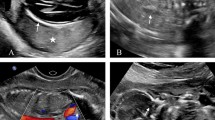Abstract
Six patients who presented with craniofacial anomalies, musculoskeletal anomalies including elongated and bowed (serpentine) fibulae, and polycystic kidneys are reported. This association of anomalies is referred to as serpentine fibula polycystic kidney syndrome (SFPKS) and is currently interpreted as a manifestation of Hajdu-Cheney syndrome (HCS). We report a new instance of this association of anomalies and review the clinical and radiographic features of HCS and of the reported cases of SFPKS.





Similar content being viewed by others
References
Exner GU (1988) Serpentine fibula – polycystic kidney syndrome: a variant of the Melnick-Needles syndrome or a distinct entity? Eur J Pediatr 147:544–546
Ramos FJ, Kaplan BS, Bellah RD et al (1998) Further evidence that the Hajdu-Cheney syndrome and the “serpentine fibula-polycystic kidney syndrome” are a single entity. Am J Med Genet 78:474–481
Brennan AM, Pauli RM (2001) Hajdu-Cheney syndrome: evolution of phenotype and clinical problems. Am J Med Genet 100:292–310
Dereymaeker AM, Christens J, Eeckels R et al (1986) Melnick-Needles syndrome (osteodysplasty). Clinical and radiological heterogeneity. Helv Paediatr Acta 41:339–351
Fryns JP (1997) Serpentine fibula syndrome: a variant clinical presentation of Hajdu-Cheney syndrome? Clin Dysmorphol 6:287–288
Shaw D (1987) Melnick-Needles or Cheney-Hajdu? Helv Paediatr Acta 42:195
Majewski F, Enders H, Ranke MB et al (1993) Serpentine fibula-polycystic kidney syndrome and Melnick-Needles syndrome are different disorders. Eur J Pediatr 152:916–921
Kaplan P, Ramos F, Zackai EH et al (1995) Cystic kidney disease in Hajdu-Cheney syndrome. Am J Med Genet 56:25–30
Albano LM, Bertola DR, Barba MF et al (2007) Phenotypic overlap in Melnick-Needles, serpentine fibula-polycystic kidney and Hajdu-Cheney syndromes: a clinical and molecular study in three patients. Clin Dysmorphol 16:27–33
Ellison DA, Ellis EN, Kokoska ER (2007) Hajdu-Cheney syndrome: report of a case. Pediatr Dev Pathol 10:470–476
Rosenmann E, Penchas S, Chohen T et al (1977) Sporadic idiopathic acro-osteolysis with cranio-skeletal dysplasis, polycystic kidneys and glomerulonephritis: a case of the Hajdu-Cheney syndrome. Pediatr Radiol 6:116–120
Zahran M, Eklöf O, Ritzen M (1984) Arthro-osteo-renal dysplasia: report of a case. Acta Radiol Diagn 25:39–43
Author information
Authors and Affiliations
Corresponding author
Rights and permissions
About this article
Cite this article
Currarino, G. Hajdu-Cheney syndrome associated with serpentine fibulae and polycystic kidney disease. Pediatr Radiol 39, 47–52 (2009). https://doi.org/10.1007/s00247-008-0992-9
Received:
Revised:
Accepted:
Published:
Issue Date:
DOI: https://doi.org/10.1007/s00247-008-0992-9




